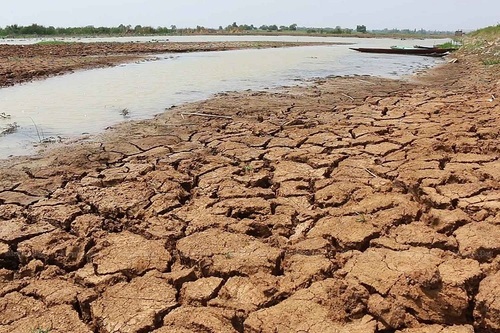The year 2020 was one of the three warmest years in the history of climate observations. The year saw catastrophic natural disasters of devastating proportions. There were record high temperatures in Australia, leading to massive wildfires, the same happened in Brazil and the west coast of the United States, and drought in South America. Large-scale flooding in Africa, China and Southeast Asia, a record hurricane season occurred in the Atlantic.
In 2050, the living space of more than a billion people may be threatened: hurricanes, floods, water and food shortages will lead to the fact that many living spaces will no longer be livable, — reports the German edition Handelsblatt, citing the latest research. Scientists identify 31 states that they believe may not be able to cope with environmental and political change in the coming decades.
Given these circumstances, experts warn of powerful migration flows that could provoke large-scale political turmoil, which could primarily affect European countries that are considered relatively crisis-resistant. It is predicted that a large number of people will leave their homeland and seek refuge in safer regions, and not only in Europe. Thus, hundreds of millions of people could flee Pakistan, Iran or Ethiopia.
All of this has already had serious consequences for the fauna: polar bears are starving because of the shrinking Arctic ice sheet, sea creatures are dying out as the world’s oceans become more acidic, absorbing carbon dioxide from the atmosphere, koalas are becoming victims of raging forest fires, and various animals in Australia are dying out in large numbers.
Since the turn of the century, the scale of heat and drought on Earth has reached previously unimaginable levels. The climate has become hotter and drier since the 1990s, something not seen in 260 years. It was reported earlier that an analysis of satellite imagery from 1979 to 2017 showed: a warming climate was increasing the risk that hurricanes would get bigger and stronger with sustained winds by about 8 percent in each decade, with speeds exceeding 180 km/h. This phenomenon cannot be explained by natural fluctuations and after a certain point the catastrophic deterioration will become irreversible. This statement was made by an international team of scientists from South Korea, Japan, Sweden, the United States and China, which published their article in Science.
Numerous wildfires have ravaged the West Coast of the United States since last fall, destroying more than 5,800 buildings. Completely dried out areas may only be a harbinger of what the future holds for North America: according to a new study, climate change in the US could lead to drought that would last for decades, reports the Austrian publication Der Standard.
A number of European countries are also experiencing the most severe water shortages since the mid-16th century. The situation has deteriorated even further in recent decades, with experts citing low precipitation, dry winters and the warmest period from January to April in at least the past 100 years as reasons for the disaster. Because of the extreme heat, some regions of Germany are already experiencing a shortage of drinking water.
Scientists from McGill University and Idaho State University in Boise also reported a strong increase in the risk of such extreme weather events due to global warming in the scientific magazine Science Advances.
The Earth is headed for the worst-case scenario of climate change, driven by the active melting of glaciers, according to a study of scientists at the University of Leeds in the UK and the Danish Meteorological Institute. Over the past 30 years, sea level has already risen by 1.8 cm, and the rate of melting of the Greenland and Antarctic ice sheets continues to increase. If this continues even at the same rate, ocean levels will rise another 17 centimeters in the coming decades, which could worsen the flooding that will affect the lives of 16 million people by the end of the century.
Scientists from an international team aboard the Russian research vessel Akademik Keldysh have discovered that “sleeping giants of the carbon cycle” — large areas of frozen methane accumulations off the coast of Eastern Siberia in the Arctic Ocean — have begun to release actively, and the gas is rising and triggering a new chain of dangerous climatic reactions.
Global warming has caused the temperature of the Mediterranean Sea to rise by at least 0.5 Cº in the last 15 years. This has had particularly dire consequences for Italy, where the number of extreme weather anomalies has increased fivefold in the span of a decade. Due to climate change, heavy rains are pouring more and more often, making Italy a country of floods. After the coronavirus, the government in Rome wants to allocate €7 billion from an aid fund to help strengthen cities and villages, to protect them from the effects of weather anomalies.
To visualize how global warming will affect the climate of your hometown, EarthSystemData Ltd together with the Center for Climate Change Research at the University of East Anglia have developed a mobile application (ESD Research is available for download).
The tide of alarm over climate change has been rising steadily on every continent in recent years.
According to an unprecedented survey of 550,000 people under the age of 18 conducted by the United Nations Development Program in 50 countries around the world, two-thirds of those surveyed consider climate change to be a “global emergency.” The effects of global warming may be worse than the effects of the COVID-19 pandemic. This was announced by UN Secretary General António Guterres at a ceremony at the Paris Peace Forum on November 12. “The European Union has stated its intention to become the first continent with zero carbon emissions and has linked action to recover from the pandemic to this need,” Guterres pointed out. The UN Secretary General brought up the fact that Great Britain, Japan and the Republic of Korea, as well as 110 other countries have declared their intention to achieve zero carbon emissions by 2050, and China – no later than 2060. The researchers emphasize the importance of such a step on the part of China and Japan, given that both of these countries have very high carbon dioxide emission levels. The development of green technology is happening so rapidly that it is becoming an affordable and even the most effective option for improving the transportation system and infrastructure.
It has been five years since the Paris climate agreement, abandoned by the US, was signed. But with a new administration in the White House, there are now great hopes for cooperation among all countries under the Paris Agreement. Here’s hoping that not everything is lost yet.
Author
Vladimir Danilov, political observer, exclusively for the online magazine “New Eastern Outlook”.




